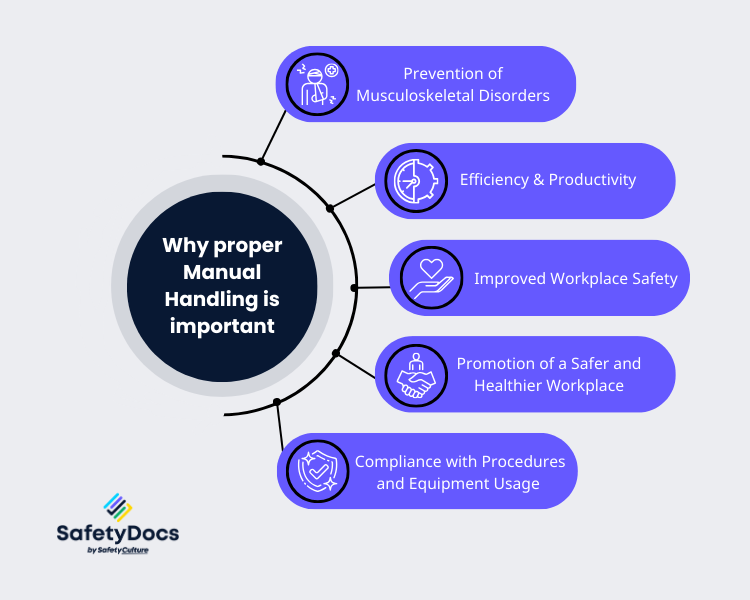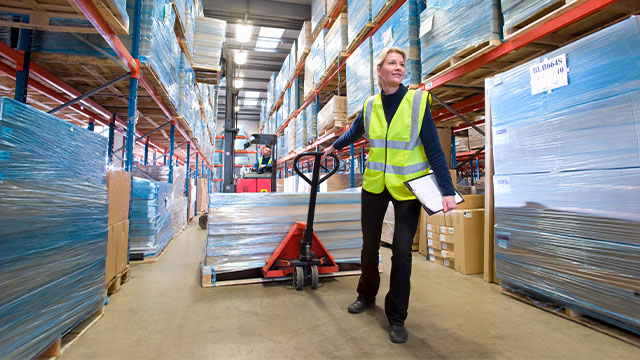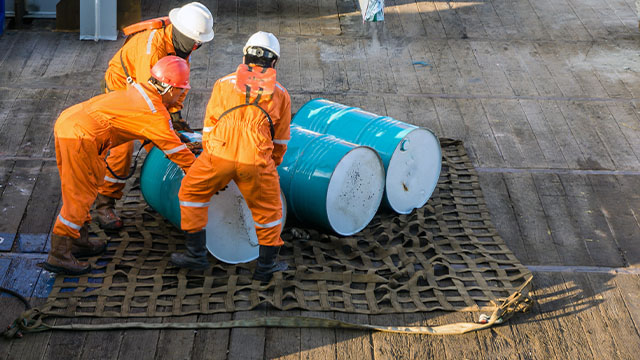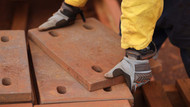Manual handling, the act of moving objects by hand, is a common task across various industries. While this type of work can be beneficial to workers and employers, it can also be a source of injury. The statistics on work-related injuries show that lifting, pushing, pulling, or bending was the most common cause of injury or illness, accounting for 24% of all cases in the 2021-22 financial year. Moreover, statistics on manual handling injuries in Australia reveal that claims related to body stress injuries accounted for the highest percentage, standing at 37%.
Let's delve into the world of manual handling by exploring its importance, risks, and providing practical guidance on how to execute manual handling tasks safely and efficiently.
Understanding Manual Handling
What is Manual Handling?
Manual handling, or what we call manual tasks, includes any activity where you use your body to lift, lower, push, pull, carry, move, hold, or restrain anyone, anything, or even animals. It is a common task in many workplaces, including construction, healthcare, and retail. However, some manual handling tasks can be hazardous and may cause injuries or illnesses. Examples of hazardous manual handling tasks include lifting heavy and large objects, using a jackhammer, working on a conveyor line, and entering data into a computer
Here are more examples of hazardous manual handling tasks:
- Moving and carrying large sacks of grain
- Using a jackhammer
- Sitting at a cramped desk and typing for long periods at a time
- Using tin snips with widely spaced grips
- Steering a heavily loaded trolley through a busy warehouse
- Stacking shelves
- Pruning plants
- Helping a person into a bath
- Using a chainsaw
- Operating a lawn mower
Manual Handling Hazards
Manual handling hazards refer to potential risks and injuries that can occur due to the manual lifting, carrying, lowering, or moving of heavy objects. These tasks can lead to musculoskeletal disorders (MSDs), which affect the muscles, nerves, blood vessels, ligaments, and tendons. Here are some common manual handling hazards:
- Heavy Loads: Lifting or carrying loads that are too heavy for one person can cause strain injuries. This also applies when the load is too large to see over, potentially leading to accidents.
- Repetitive Tasks: Performing the same manual handling task repeatedly can lead to repetitive strain injuries (RSI). This is common in jobs that require constant lifting or carrying.
- Awkward Postures: Bending, twisting, or reaching while handling loads can put pressure on the back and other parts of the body, leading to injuries.
- Poor Environment: Slippery floors, cluttered workspaces, or insufficient lighting can increase the risk of accidents during manual handling tasks.
- Duration of Activity: Prolonged periods of manual handling without sufficient breaks can result in fatigue, increasing the risk of injury.
- Vibration: Regular exposure to vibration, such as when using certain machinery, can lead to health issues like Hand-Arm Vibration Syndrome (HAVS).
- Temperature: Working in extreme temperatures can affect a person's ability to safely perform manual handling tasks. Cold can reduce muscular strength, and heat can cause fatigue.
Musculoskeletal Disorders (MSDs)
Musculoskeletal disorders (MSDs) are a significant health issue in Australia, affecting millions of people. Known as MSDs, these are injuries or diseases that affect our body's movement or musculoskeletal system. MSD isn't a result of an injury caused by crushing, entrapment, or cutting resulting from the mechanical operation of plant machinery. Instead, it arises either suddenly or over time due to various factors impacting the musculoskeletal system.
MSDs are responsible for a significant burden of disease in Australia, ahead of both mental health and unintentional injuries. Low back pain (LBP) was the most prevalent musculoskeletal condition and was the leading driver of disability burden in Australia. The recognised leading cause of MSDs is manual handling.
Types of MSDs
MSDs can manifest in several ways, such as:
- Sprains and strains: These are injuries to the muscles, ligaments, and tendons, often caused by a sudden wrench or twist.
- Back injuries: Damage to the muscles, tendons, ligaments, spinal discs, nerves, joints, and bones in the back.
- Joint and bone injuries or degeneration: This includes injuries to the shoulder, elbow, wrist, hip, knee, ankle, hands, and feet.
- Nerve injuries or compression: Conditions like carpal tunnel syndrome fall under this category.
- Muscular and vascular disorders: These can occur as a result of hand-arm vibration.
- Soft tissue injuries: This includes conditions like hernias.
- Chronic pain: persistent discomfort that extends beyond a duration of 12 weeks.

Why is Proper Manual Handling Important?
Given the risks associated with manual handling, it's important to understand the importance of proper technique. The human body is more precious than any piece of machinery. Proper manual handling helps ensure its protection and preservation. Here are some benefits of proper manual handling:
Prevention of Musculoskeletal Disorders (MSDs)
Incorrect manual handling can lead to a wide range of injuries and health problems, especially MSDs. This can have a serious impact on an individual's health and well-being. Proper manual handling can help prevent MSDs, as well as other injuries that may arise due to incorrect techniques.
Efficiency & Productivity
Good manual handling techniques are essential for efficiency in the workplace. Using correct posture and body mechanics helps reduce strain and fatigue during manual tasks, allowing workers to complete their tasks quickly and safely. This helps increase productivity and efficiency, while also reducing the risk of accidents or injuries.
Improved Workplace Safety
Proper lifting and carrying techniques can protect workers from back injuries and other harm. Keeping the load close to the body and lifting with the thigh muscles rather than the back are examples of safe manual handling.
Promotion of a Safer and Healthier Workplace
Proper training in manual handling fosters a work environment that is not only safer and healthier but also promotes happiness. By prioritising the safety and well-being of employees, employers demonstrate their value for their workforce.
Compliance with Procedures and Equipment Usage
Manual handling training supports pre-existing procedures, such as rules on how to use certain equipment safely. Knowing how to use tools and equipment correctly can help workers stay safe and avoid accidents. This is especially important when working with heavy or bulky objects, such as furniture or machinery.

Understanding Australia's WHS Framework for Manual Handling
While the Work Health and Safety (WHS) Act serves as the primary health and safety legislation in many Australian states and territories, there are variations. For instance, Victoria operates under the Occupational Health and Safety (OHS) Act. It's crucial to be aware of these nuances and to always consult the respective state's regulatory body for detailed information.
1. Work Health and Safety Act (WHS Act):
The primary legislation provides a framework to secure the health and safety of workers. It outlines the responsibilities of a person conducting a business or undertaking (PCBU) to ensure the health and safety of workers, particularly in managing risks associated with manual tasks.
2. Work Health and Safety Regulations (WHS Regulations):
These are specific provisions that reinforce the WHS Act. In the context of manual handling, these regulations may involve identifying hazardous manual tasks, assessing related risks, and implementing control measures to manage those risks.
3.Code of Practice for Hazardous Manual Tasks:
This code offers practical advice for PCBUs to navigate risks tied to hazardous manual tasks. These can range from tasks involving repetitive motions and prolonged postures to those requiring significant force. The code delves deep into the risk management process, providing insights on control measures and guidelines for designing tasks, workstations, layouts, and environments.
4. Roles and Responsibilities:
PCBU (Person Conducting a Business or Undertaking): PCBUs are tasked with ensuring the health and safety risks stemming from hazardous manual tasks are either eliminated or minimised if that's not feasible. They are also responsible for furnishing workers with relevant information, training, and supervision concerning safe manual handling practices.
Workers: Every worker is obligated to prioritise their health and safety and to act in a manner that doesn't jeopardise the well-being of others. This includes adhering to prescribed procedures and utilising equipment that supports safe manual handling.
WHS Duties
About hazardous manual tasks, health and safety duties are held by:
- Person Conducting a Business or Undertaking (PCBU): They must eliminate or minimise risks from hazardous tasks whenever practicable. They're also required to consult workers on health and safety matters.
- Designers, manufacturers, importers, installers, and suppliers: These stakeholders have a significant role in reducing the risks of Musculoskeletal Disorders (MSDs) often associated with poorly designed work areas or equipment. They need to ensure their products are safe and provide necessary information about them.
- Officers: Company directors, for example, have a duty to ensure the PCBU complies with health and safety regulations. This includes ensuring appropriate resources are used to minimise risks from hazardous tasks.
- Workers: Workers must take reasonable care of their health and safety and not adversely affect others. They must comply with instructions and use any provided Personal Protective Equipment (PPE).
- Other persons at the workplace: Visitors, for example, must also take care of their health and safety and follow PCBU instructions to comply with the Work Health and Safety (WHS) Act.

Principles of Safe Manual Handling
Risk Assessment
The safest and best technique for performing the task is determined by considering the environment, the ability of the handler to perform the task, and the nature of the load (animate or inanimate). Risks can be identified and assessed in the workplace by following these steps:
- Walkthrough the Workplace: Walk through the workplace and look for potential hazards. This includes identifying manual handling tasks that involve lifting, pushing, pulling, holding, restraining, throwing, and carrying.
- Talk to Workers: Talk to workers to identify any manual handling risks they have identified or experienced.
- Assess the Risks: Once hazardous manual handling tasks have been identified, assess the risk of the hazardous manual handling causing MSDs. This includes identifying the factors that contribute to the risk of injury, such as the weight and size of the load, the frequency and duration of the task, and the work environment.
- Implement Control Measures: Implement control measures to eliminate or reduce the risk of injury associated with manual handling tasks. This includes using machines to remove or reduce manual handling or redesigning work processes to eliminate the need for it.
- Provide Training and Instruction: Provide training and instruction to workers on safe manual handling techniques
Plan
Before lifting or moving an object, always remember to follow the TILE approach to assess the surrounding area carefully. This includes checking the task, individual, load, and environment. TILE means Task, Individual, Load, Environment.
- Task: The manual handling activity and employee needs.
- Individual: Employee's capabilities including age, health, training, and strength.
- Load: Factors of the object being moved like weight, size, shape, and surfaces.
- Environment: Area of activity, checking for potential hazards.
Proper Technique
Use correct lifting techniques. This usually involves keeping the load close to the body, using the legs to lift (not the back), and avoiding twisting or jerking movements.
- Position the Feet: The handler should position their feet shoulder-width apart and one foot slightly in front of the other to maintain balance. The vertebral column should be in correct alignment in the normal spinal curvature
- Get a Secure Grip: The handler should get a secure grip on the load, using both hands if possible. The load should be held close to the body
- Keep the Load Close to the Body: The handler should keep the load close to the body to reduce the risk of injury. This can be achieved by bending the knees and keeping the back straight.
- Maintain Good Posture: The handler should maintain good posture throughout the task, keeping their head up and neck straight, and bracing abdominal muscles to support the back
Use of Equipment
Where possible, use mechanical aids or equipment like trolleys, forklifts, or hoists to move heavy items. This reduces the risk of injury to handlers and helps improve efficiency. Protective clothing can also be used to protect employees from potential hazards such as cuts, scrapes, or burns.
Wear comfortable clothing that allows free movement, and shoes that have flat heels, covered toes, and provide good support to the feet. Articles of jewellery that could become entangled should be removed
Training and Education
Workers should receive adequate training on safe manual handling techniques and the use of any relevant equipment. Employers should ensure that the training provided is adequate and effective and employees should take steps to stay informed about the latest safety regulations. Manual handling training typically includes:
- Understanding of Manual Handling: Introduction to what manual handling is and why it's important for safety.
- Manual Handling Regulations: Explanation of relevant laws and regulations that apply to manual handling.
- Risk Assessment: Training on how to assess risks associated with manual handling tasks.
- Safe Lifting Techniques: Instructions on how to lift, carry, push, and pull objects safely to prevent injuries.
- Practical Exercises: Hands-on training to practise safe manual handling techniques.
- Health Implications: Information on potential health risks and injuries associated with incorrect manual handling.
Communication
Employers should ensure that there is effective communication between all parties involved in manual handling activities. This includes supervisors, workers, and other persons who may be affected by the tasks being performed. Communication should include information on:
- Availability of equipment
- Warning signs of potential hazards
- Any changes to work processes or procedures
- Emergency plans
- Safe work practices
You can also conduct regular toolbox talks to ensure that everyone is aware of the safety regulations and best practices for manual handling tasks.
Ergonomics and Workplace Design
Good ergonomics and workplace design are essential in manual handling tasks. Ergonomics is a key factor in ensuring safe manual handling at work. It's about tailoring workplaces, systems, and tasks to suit the worker's abilities and limitations, which can boost productivity while reducing the risk of injuries.
- Choosing Equipment: The equipment used should be suitable for the materials being handled, the workspace layout, and the tasks being performed. For instance, adjustable workstations can cater to different body sizes and postures, reducing strain and discomfort.
- Designing the Workstation: Workstations should be designed to prevent excessive bending, twisting, and stretching. Tool supports can be utilised for prolonged tool use, helping to lessen fatigue and prevent Musculoskeletal Disorders (MSDs).
- Involving Employees: Workers should have an active role in the ergonomic process by expressing their concerns and suggestions. Their firsthand experience can provide valuable insights into identifying and mitigating ergonomic hazards.
- Workplace Safety: Altering the workplace design can effectively prevent manual handling injuries. This may involve reorganising workspaces to minimise heavy lifting, adjusting storage areas to reduce the need for excessive reaching, or implementing mechanical aids to assist with material handling.
- Ergonomic Standards: Adherence to ergonomic standards like ISO 11228 series, which sets out ergonomic recommendations for various dynamic manual handling tasks, can further enhance workplace safety.
Complete Your Manual Handling Safety Techniques With SafetyDocs
SafetyDocs by SafetyCulture is a leading provider of documented Workplace Health and Safety products in Australia. We offer a range of safety templates and tools to help businesses comply with safety regulations and standards. We can help you complete the manual handling safety process with our comprehensive library of safety documents. Our documents are tailored for various industries, government requirements, and workplace contexts.
With SafetyDocs, you can get started with a variety of easy-to-use tools and templates, including Manual Handling Risk Assessments, Safe Work Method Statements (SWMS), Job Safety Analysis (JSA) forms, Toolbox Talks, and more. Check out the following link to explore our range of safety documents for manual handling:
- Manual Handling Management Plan
- Manual Handling Safe Work Method Statement
- Manual Handling Task Register
- Manual Handling Safe Operating Procedure
Create a workplace that both meets legal standards and promotes a safe work environment for your employees. Get started today with the help of SafetyDocs!.
Our team of experts is dedicated to providing accurate and informative content. Craig Cruickshank, our senior HSEQ advisor at SafetyDocs by SafetyCulture has reviewed this blog post to ensure the highest level of quality.
Learn more about Craig's work on LinkedIn for more industry insights.
Available for instant download and supplied in fully editable MS Word format for use in your business.
Please note that the above information is provided as a comment only and should not be relied on as professional, legal or financial advice.
Share This Article
